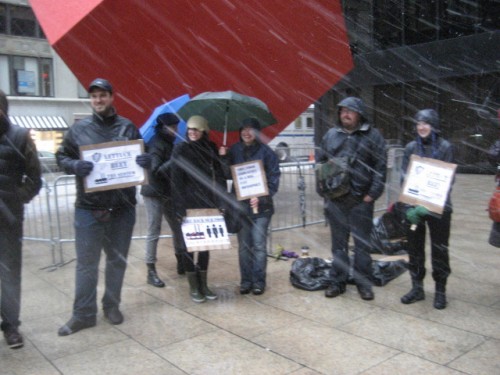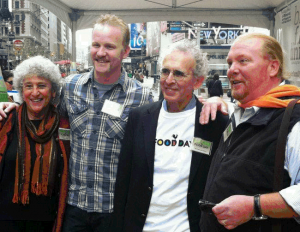Join Health Affairs for a virtual conversation between me and Angela Odoms-Young of Cornell University discussing the evolution of US food and nutrition policy, the current policy landscape, and thoughts on what lies ahead. It’s at 1:00 p.m. EDT. To join the Webinar, register here.
Surprise! Consumers don’t trust the meat industry
According to MeatingPlace, the Center for Food Integrity asked more than 2,000 respondents to rank a field of 8 possible priorities for the meat industry. The rankings of meat industry respondents were quite different from those of consumers.
Meat industry respondents ranked profitability as #2 and humane treatment of farm animals as #8.
In contrast, consumer respondents ranked profitability way down the list as #7 but humane treatment of farm animals as #4.
These disconnects, say industry observers, are serious and “feed an overall distrust of commercial ag operations.” The survey report explains:
There is an inverse relationship between the perception of shared values and priorities for commercial farms. Consumers fear that commercial farms will put profit ahead of principle and therefore cut corners when it comes to other priority issues. As farms continue to change in size and scale we have to overcome that bias by effectively demonstrating our commitment to the
values and priorities of consumers.
Maybe the message is getting out there?
Sugar 1, HFCS 0, at least for the moment
The public relations firm for the Sugar Association, Levick Strategic Communications, sent me a press release celebrating the victory of sugar producers against corn refiners over the question of whether high fructose corn syrup (HFCS) can be renamed “corn sugar.”
A federal judge ruled that the case brought by the Sugar Association against the Corn Refiners can proceed to trial. If you want the details, see the judge’s “order denying in part and granting in part defendents’ motion to dismiss”, and “order granting defendents’ motion to strike.”
I cannot even begin to tell you how funny I think all this is.
The Sugar Association represents growers of sugar beets and cane. They produce table sugar—sucrose—a double sugar composed of glucose and fructose linked together. In the body, sucrose is quickly split to glucose and fructose.
The Corn Refiners represent processors of corn (obviously). They produce HFCS, a syrup made of glucose and fructose.
From a biological standpoint, glucose and fructose are the same no matter where they come from. Biochemically, sucrose, glucose, and fructose are all sugars.
HFCS used to be a lot cheaper than sucrose, but what with all the corn used for ethanol, the price gap has narrowed. As a result, and because HFCS has gotten a bad reputation, companies are dropping it in favor of sucrose. The Corn Refiners are upset about that and think a name change would help.
The Sugar Association thinks it’s just great that HFCS has a bad reputation and does not want table sugar to be confused with corn sugar.
Both of these trade associations are acting totally in self-interest. Neither cares at all about public health. The lawsuit is entirely about corporate profits, not public welfare.
The Sugar Association is famous for protecting a system of quotas and tariffs that transfers money from American consumers to the coffers of sugar producers. Its aggressive actions in its own self interest are legendary (see, for example, its threatening letter to me when Food Politics came out—this and my reply are posted at the end of the About section).
And I’ve written previously about the Corn Refiners’ consistently bad self-interested behavior.
Both trade associations behave with appalling disregard for the public.
In this case, the public interest is clear: everyone would be healthier eating less table sugar and HFCS.
Happy Food Day!
Center for Science in the Public Interest (CSPI) launched Food Day yesterday with a splendid lunch right in the middle of Times Square. I got to be one of the lucky eaters.
The purpose of Food Day is to promote discussion of critical issues in agriculture, food, nutrition, and health. Its goals:
- Promote healthy eating.
- Support sustainable farms.
- Expand access to food and alleviate hunger.
- Reform factory farms.
- Curb junk-food marketing to kids.
For half an hour, it got big-time billboard coverage.
The lunch was nutritionally correct and quite delicious, thanks to Ellie Krieger who did the menus and is posed here with Mario Batali.
Tom Farley, director of New York City’s Health Department, gave the opening speech with updates on his department’s new “cut down on sodas” campaign. For example: One soda a day translates to 50 pounds of sugar a year, and you have to walk three miles to burn off the calories in one 20-ounce soda! He’s here with Michael Jacobson who has directed CSPI since the early 1970s.
Tom Chapin sang from his album for kids, “give peas a chance.”
It was all anyone needed to be inspired to join the food movement and sign up for the food day campaign!
Later addition: Mike Jacobson sent this one with Morgan Spurlock.
On Denmark’s “fat tax”
I have a commentary in the October 23 issue of New Scientist (UK):
World’s first fat tax: what will it achieve?
Enviably healthy Denmark is leading the way in taxing unhealthy food. Why are they doing it, and will it work
THE Danish government’s now infamous “fat tax” has caused an international uproar, applauded by public health advocates on the one hand and dismissed on the other as nanny-state social engineering gone berserk.
I see it as one country’s attempt to stave off rising obesity rates, and its associated medical conditions, when other options seem less feasible. But the policies appear confusing. Why Denmark of all places? Why particular foods? Will such taxes really change eating behaviour? And aren’t there better ways to halt or reverse rising rates of diet-related chronic disease?
Before getting to these questions, let’s look at what Denmark has done. In 2009, its government announced a major tax overhaul aimed at cushioning the shock of the global economic crisis, promoting renewable energy, protecting the environment, discouraging climate change, and improving health – all while maintaining revenues, of course.
The tax reforms make it more expensive to produce products likely to harm the environment and to consume products potentially harmful to health, specifically tobacco, ice cream, chocolate, candy, sugar-sweetened soft drinks, and foods containing saturated fats.
Some of these taxes took effect last July. The current fuss is over the introduction this month of a tax on foods containing at least 2.3 per cent saturated fat, a category that includes margarine, salad and cooking oils, animal fats, and dairy products, but not – thanks to effective lobbying from the dairy industry – fluid milk.
Copenhagen is the home of René Redzepi’s Noma, voted the world’s best restaurant for the past two years. To Americans, “Danish” means highly calorific fruit – and cheese-filled breakfast pastries. Despite such culinary riches, the Nordic nation reports enviable health statistics and a social support system beyond the wildest imagination of inhabitants of many countries. Danish citizens are entitled to free or very low-cost childcare, education and healthcare. Cycle lanes and high taxes on cars make bicycles the preferred method for getting to school or work, even by 63 per cent of members of the Danish parliament, the Folketing.
Taxes pay for this through policies that maintain a relatively narrow gap between the incomes of rich and poor. The Danish population is literate and educated. Its adult smoking rate is 19 per cent. Its obesity rate is 13.4 per cent, below the European average of 15 per cent and a level not seen in the US since the 1970s. Denmark has long used the tax system to achieve health goals. It has taxed candy for nearly 90 years, and was the first country to ban trans-fats in 2003.
Because its level of income disparity is relatively low, the effects of health taxes are less hard on the poor than in many other countries. But the Danes want their health to be better. Obesity rates may be low by US standards, but they used to be lower – 9.5 per cent in 2000. Life expectancy in Denmark is 79 years, at least two years below that in Japan or Iceland. The stated goal of the tax policies is to increase life expectancy as well as to reduce the burden and cost of illness from diet-related diseases.
Like all taxes, the “health” taxes are supposed to raise revenue: 2.75 billion Danish kroner annually ($470 million). The tax on saturated fat is expected to account for more than one-third of that. Since all food fats – no exceptions – are mixtures of saturated, unsaturated, and polyunsaturated fatty acids, the tax will have to be worked out food by food. Producers must do this, pay the tax, and pass the cost on to consumers.
Taxes on cigarettes are set high enough to discourage use, especially among young people. But the food taxes are low, 0.34 kroner on a litre of soft drinks, for example. The “fat” tax is 16 kroner per kilogram of saturated fat. In dollars, the taxes will add 12 cents to a bag of crisps and 40 cents to the price of a burger. Whether these amounts will discourage purchases remains to be seen.
Other countries are playing “me too” or waiting to see the results of Denmark’s experiment. Hungary has imposed a small tax on sweets, salty snacks, and sugary and caffeinated drinks and intends to use the revenues to offset healthcare costs. Romania and Iceland had such taxes but dropped them, whereas Finland and Ireland are considering them. Surprisingly, given his party’s anti-nanny state platform, UK prime minister David Cameron is suggesting food taxes to counter the nation’s burgeoning obesity crisis. The US has resisted calls for taxes on sugar-sweetened beverages, not least because the soft drink companies spent millions of dollars on defeating such proposals.
Leaving aside the usual criticisms, such as the impact on poorer people, I have a different reason for being troubled by tax interventions. They aim to change individual behaviour, but do little to change the behaviour of corporations that make and market unhealthful products, spending vast fortunes to make them available, desirable and socially acceptable.
Today, more and more evidence demonstrates the importance of food environment factors, such as processing, cost and marketing, in influencing food choices (The Lancet, DOI: 10.1016/S0140-6736(11)60813-1). Raising taxes is one way to change that environment by influencing the cost to the consumer. But governments seriously concerned about reducing rates of chronic disease should also consider ways to regulate production of unhealthy products, along with the ways they are marketed.
In the meantime, let us congratulate Denmark on what could be viewed as a revolutionary experiment. I can’t wait to see the results.
Marion Nestle is the author of Food Politics and What To Eat and is the Paulette Goddard Professor of Nutrition, Food Studies, and Public Health at New York University
Food movement: Occupy Wall Street and Big Food: October 29
 Thanks to Erica Lade for sending the poster and these links to articles connecting Occupy Wall Street to the Food Movement:
Thanks to Erica Lade for sending the poster and these links to articles connecting Occupy Wall Street to the Food Movement:
- From Slow Food USA
- From Civil Eats
- From the Institute for Agriculture and Trade Policy
- From Mother Jones
And in case you missed this week’s New Yorker:

Join the food movement!
IOM releases tough report on front-of-package labeling
The Institute of Medicine (IOM) just released its second report on front-of-package (FOP) labeling. It tells FDA to allow only four items in any front-of-package evaluation scheme:
- Calories
- Saturated and trans fat
- Sodium
- Sugars
To display this, the IOM committee recommends a point system based on levels of saturated and trans fats, sodium, and sugars for evaluating food products. The points are to be indicated with check marks or stars. Here is an example of how stars might be used to indicate products that qualify for zero, one, two, or three points.
I’m guessing that anything this clear and understandable will elicit storms of protest.
Recall that food companies have been setting their own nutrition criteria for evaluating their very own products and identifying the “better-for-you” or “more nutritious” products with special front-of-package logos. By company standards, many of their products qualify for the logos.
To deal with the multiplicity and absurdity of such schemes, the FDA asked the IOM to take a look at the various FOP logos that were out there and recommend how to clean up the mess. The first IOM report said the FDA should allow FOP labels to state only calories, saturated and trans fat, and sodium, but not sugars (this last was a mistake, I thought).
But—while the FDA was waiting for the IOM to produce its next report, the Grocery Manufacturers Association (GMA) and Food Marketing Institute (FMI) jumped the gun. Their preemptive logo included “positive” nutrients such as vitamins and fiber along with the “negatives.” This scheme is already in use on food packages.
The IOM committee was faced with an impossibly difficult task: to come up with a front-of-package scheme that would reduce the overall nutritional quality of processed foods to the sum of a few key factors.
Given strong industry marketing pressures to retain front-of-package labels—and the lack of an option to remove them altogether—the committee did the best it could with an inherently bad idea.
Why a bad idea? FOP labels are a tool for selling, not buying. They make highly processed foods look healthier, whether or not they really are.
And whether slightly better-for-you processed foods assessed by this method will help anyone to make better food choices and to be healthier remains open questions.
Nevertheless, the IOM proposal is a huge improvement over what food companies are now doing. I consider it courageous.
Why courageous? Because the scheme makes it so easy to distinguish products that qualify for the various point levels.
For example, here are some products that qualify for stars:
- Toasted oat cereal
- Oatmeal, instant
- Milk, 1% fat
- Yogurt, plain nonfat
- Salad dressing, light
- Orange juice, 100%
- Grape juice, 100%
- Kidney beans, canned
- Peanut butter
- Tomato soup, “healthy”
- Tomatoes, canned
Examples of products that do not qualify:
- Animal crackers
- Graham crackers
- Breakfast bar
- Sweetened toasted oat cereal
- Oatmeal, instant with fruit, nuts
- Chocolate milk
- Yogurt, sweetened
I can’t wait to see the GMA and FMI press release on this report.
And the FDA must now take this report under consideration to begin its interminable rulemaking process.
Why, you might ask, does any of this matter? Aren’t questions about what food companies put on package labels basically trivial? Don’t FOP label fights divert attention from other, more important food issues?
Maybe, but I see this as a test of the FDA’s authority to regulate and set limits on any kind of food industry behavior. If the FDA cannot mandate a label that might help consumers choose healthier food options or refuse to permit labels that mislead consumers, it means the public has little recourse against any kind of corporate power.
I think this matters, and I’ll bet food companies do too.
And now, sit back and watch the lobbying begin!
That did not take long: Here’s the GMA press release—fairly tame all things considered:
The Institute of Medicine’s Committee on Examination of Front-of-Package Nutrition Rating Systems and Symbols report adds a perspective to the national dialogue about front-of-pack nutrition labeling. In the meantime, food and beverage companies have developed a real-world program that delivers real value to real consumers in real time.
Consumers have told us that they want simple and easy to use information and that they should be trusted to make decisions for themselves and their families. The most effective programs are those that consumers embrace, and consumers have said repeatedly that they want to make their own judgments, rather than have government tell them what they should and should not eat. That is the guiding principle of Facts Up Front, and why we have concerns about the untested, interpretive approach suggested by the IOM committee.
My translation: Consumers prefer to have the food industry’s “Facts Up Front” tell them what to eat? I don’t think so.
.
Consumer groups complain to FTC about PepsiCo’s digital marketing to kids
This morning, the Center for Digital Democracy announced that consumer groups have filed a complaint (and see the appendices) with the Federal Trade Commission against PepsiCo.
Why? Because of the ways PepsiCo uses digital marketing techniques to push its products to children and adolescents.
These include:
- Disguising marketing as video games, concerts, and other “immersive” experiences
- Claiming to protect teen privacy while collecting a wide range of personal information
- Using viral techniques that violate FTC guidelines
The report points to Pepsi’s Hotel 626 video game as a particularly egregious example.
Also this morning, Public Health Law & Policy released a comprehensive report on the kinds of digital marketing tactics that are now used routinely by fast food, snack food, and soft drink companies. The report identifies specific marketing campaigns from PepsiCo, McDonald’s, and others that exploit kids’ use of digital media.
I can’t wait to see what the FTC does with this.
In the meantime, here’s Michele Simon’s enlightening report on what it’s like to play Hotel 626.
And Lori Dorfman of the Berkeley Media Studies Group sends these case studies on digital marketing to kids:
- McDonald’s Avatar
- Multicultural marketing
- Coca-Cola’s digital ads
- PepsiCo/Frito Lay/Doritos—Hotel 626
- PepsiCo/Mountain Dew/Dewmocracy











